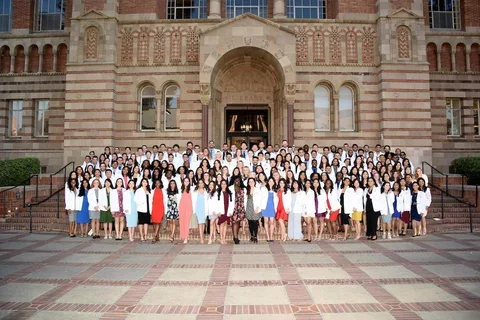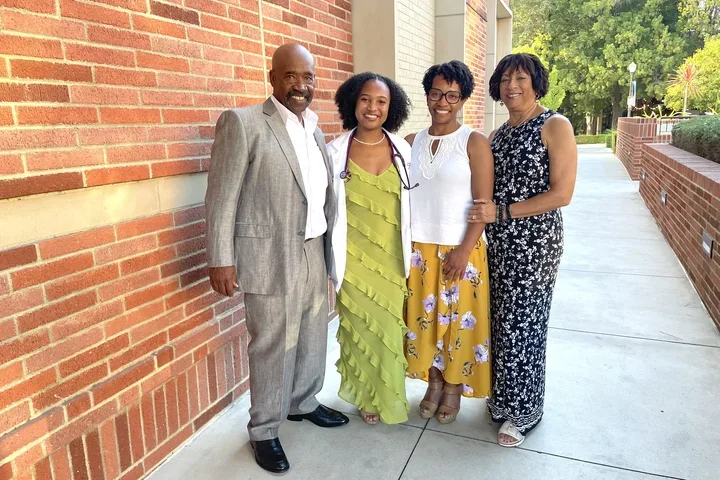A make-up White Coat Ceremony symbolized the resilience of DGSOM students

‘You are now about to then enter your clinical curriculum at a time in this country and world where healthcare is being viewed differently’
Alan Li, class vice president of The David Geffen School of Medicine at UCLA’s Class of 2024, understands the numerous sides to the symbolism of the White Coat Ceremony, a symbolic rite of passage for students beginning their journey into medicine.
“I’m a first-generation Asian-American student, so it really means a lot to my grandmother and parents to see the white coat,” says Li, who has wanted to become a doctor since he was 9 years old. “The white coat symbolizes a tremendous amount of responsibility for someone else’s health and emotional well-being.”
The DGSOM White Coat Ceremony which took place on Feb. 24 at Royce Hall on the UCLA campus was a make-up ceremony to the standard fall event in August 2020.
It’s important to do the ceremony at the beginning of medical school because some students may view it as a continuation of college, says Clarence Braddock III, MD, MPH, MACP, vice dean for education and chief medical education officer at the DGSOM.
“Students should recognize that they're now learning with a different intention in mind,” Dr. Braddock says. “Everything that they learn from now on will be in service of some future patient.”
Given recent and historical injustices, current events and the state of health care, this student class is uniquely positioned to make a difference in the world of medicine, said this year’s keynote speaker, Oluwaferanmi Okanlami M.D., MS, adjunct assistant professor of Orthopaedic Surgery at the DGSOM and assistant professor of family medicine, physical medicine and rehabilitation and urology at the University of Michigan Medical School.
“You are now about to enter your clinical curriculum at a time in this country and world where healthcare is being viewed differently,” Dr. Okanlami said at the ceremony.
At various times and to various people, the white coat itself might be viewed in different lights. For some, it may symbolize prestige, medicine and science. For others, it could be viewed as intimidation, or distance.
“For example, if you talked to pediatricians, almost no pediatrician wears a white coat,” Dr. Braddock says. “And the reason is because little kids see the doctor as a stranger and it can be intimidating and scary.”
Dr. Braddock hopes that the White Coat Ceremony signifies a shift from learning for one’s own sake to learning for the sake of future patients, and to pay homage to the positive symbolism of the white coat.
Li has seen the way in which the white coat can symbolize emotion, strength and responsibility.
“What first drew me to medicine was when my mom had a hysterectomy. Her doctor was very supportive of me as a kid, when I had to translate for my parents who don’t speak English,” he recalls. “I remember feeling really scared and her doctor reassured me and helped me navigate [her care].”
Li also remembers being at his mom’s bedside, chatting with the nurses and helping his mom order meals. Having older parents who have had serious health conditions had an impact on his views on healthcare.
“Medicine felt like something I could make a difference in,” he says.
Before entering medical school, he took a few years off from pursing his dream of becoming a doctor to financially support his family after their grocery store in Chinatown, San Francisco burned down from a faulty outlet in the cellar.
Now, Li aims to pursue orthopaedic surgery, where he can use his past experiences as a trainer and gym owner to provide access and care to low-income and underrepresented patients such as those from immigrant communities, those fighting cancer and those with mental health disorders.
Becoming an exceptional physician and…
At the beginning of medical school, Dr. Braddock provides students with his “why” statement to remind them why they chose the David Geffen School of Medicine and to encourage them to go beyond their role as a physician.
Dr. Braddock's statement reads: to empower students to become outstanding physicians who practice evidence-based, patient-centered, compassionate, equitable care for all and are going to commit another part of their career or life’s work to an area that can impact health.
That second commitment “might be research, it might be community engagement, it might be innovation or entrepreneurship – it really could be anything,” Dr. Braddock says.
That “why” statement sat deeply with second-year medical student Adam Alghalith.
“It’s made me think about other capacities in which I can help people, whether that is on Capitol Hill, in a community organization, or just helping out however I can,” Alghalith says. “There are different ways that I can advocate for patients.”
Alghalith was inspired to pursue medicine by his three older brothers, but particularly Sami, who is closest in age to him.
“Sami has Down’s syndrome and we always shared a room growing up,” Alghalith says. “We did everything together. It was always me and him versus our two older brothers.”
Alghalith became involved in the Special Olympics, helping to coach athletes. Through that experience, he became more interested in the health needs of people with intellectual and developmental disabilities. He started Special Olympics-related organizations in college and at the DGSOM.
Alghalith is also involved with the Disabilities and Chronic Illness student organization, helping to update the DGSOM curriculum and address ableism in healthcare.
Timing is symbolism, too
Rohini Nott, president of the class of 2024, thought the timing of the make-up ceremony was more symbolic and special this year than having it at the beginning of medical school.
“Even though it’s not traditionally how the white coat ceremony has been done, I think it’s even cooler this way,” she says. “Yes, we’ve worn this white coat, but now we’ve had our preclinical training and are about to start our clinical year as medical students.”
Nott says the pandemic was challenging for her and her classmates in numerous ways, but building community was among the hardest. “We had to get pretty innovative.”
They supplemented by building “quarantine-pods” or small groups of people from the same or nearby households, had frequent zoom calls and found their support system any way they could.
While working at a nursing home during the pandemic, Nott co-founded a group called the “Loneliness Project.”
“It’s been really isolating for [nursing home residents] and the technology isn’t readily available, so we wanted to do something to help out with that,” she says.
Nott and her classmates have volunteered their time in the nursing home, visiting with residents and helping with games like bingo. First-year medical students have joined in this effort by playing music and singing for the residents.
Similarly, Callie Cuff, a second-year medical student, is leaning into Dr. Braddock’s “why statement” of going beyond being a physician. As the well-being representative for the class of 2024, Cuff is responsible for ensuring the class feels supported. She helps to lead a weekly meditation.
“Despite being away from each other physically, we’ve done a good job of supporting each other throughout this really difficult time,” she says.
Watch a video of this year’s White Coat Ceremony here.



